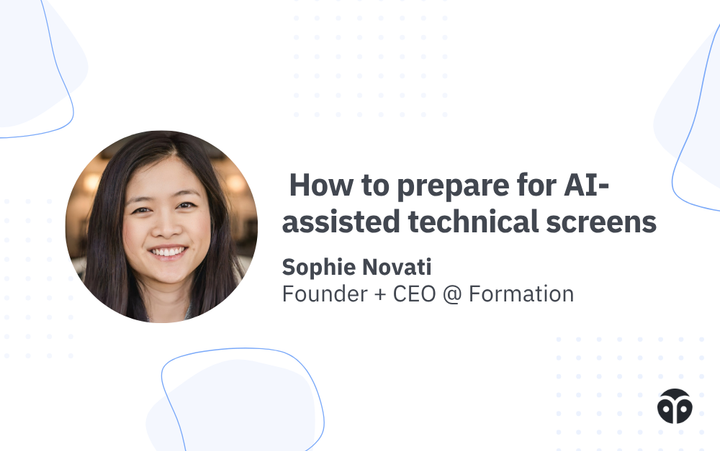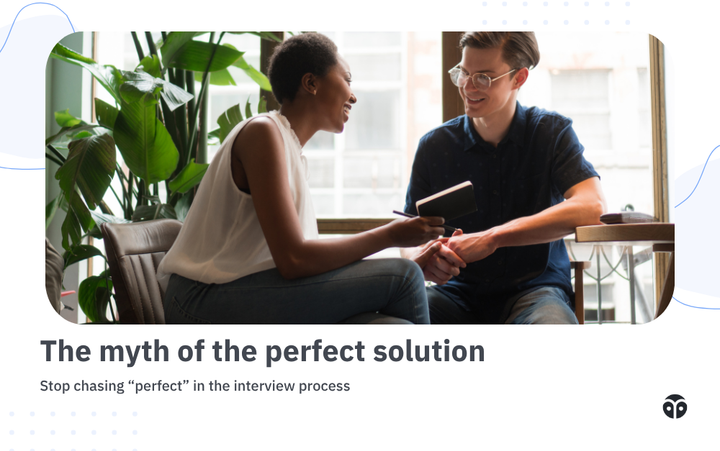How to communicate like a senior engineer in every stage of the interview
At the senior level, interviews are communication tests. Learn how to show leadership and clarity at every stage—not just behavioral rounds.

When engineers think about preparing for interviews, communication often feels secondary — something to focus on for the behavioral round, but not during the “real” technical parts.
That’s a mistake.
At the senior level, every stage of the process is a communication test. Different interviews all give hiring teams the same signal: how well can this person explain their thinking, guide others, and operate under ambiguity?
Strong communication is the difference between an answer that inspires confidence and one that leaves interviewers guessing. It’s also one of the clearest markers of seniority. Mid-level engineers can deliver features; senior engineers are trusted to lead others through complexity.
Why communication matters more at the senior level
At mid-level, success is measured by correctness and reliability: can you take a problem, code a solution, and ship it? At the senior level, correctness is only the baseline.
Interviewers are looking for signals that you can:
- Guide teammates through ambiguous problems.
- Translate complexity into actionable steps.
- Influence others and build trust through clarity.
Poor communication makes even strong technical skills invisible. We’ve seen brilliant engineers solve problems in silence, only to be rejected because the interviewer had no way to gauge their reasoning. On the flip side, we’ve seen candidates who didn’t reach the optimal solution but narrated their tradeoffs so well that interviewers left confident in their ability to thrive on the job.
Communication isn’t a separate skill — it’s the throughline that connects every part of the interview loop.
Communication across the interview loop
Recruiter screen
The recruiter call might feel like logistics — confirming your resume, salary expectations, and scheduling next steps. But it’s also the first impression that hiring teams will use to decide if they want to move you forward.
Common mistakes:
- Treating it casually, as if it doesn’t matter.
- Rambling through your background without structure.
- Giving vague or overly technical answers that leave recruiters confused.
How to communicate well:
- Be concise about your background. “I’ve spent the last three years leading backend work on X system. My focus has been scaling APIs and mentoring a small team.”
- Show enthusiasm without overselling. You don’t need to pitch yourself, just convey interest and professionalism.
- Confirm details clearly. If the recruiter shares information about the process, repeat it back: “So to confirm, I’ll have a technical phone screen followed by a system design round?”
This stage sets the tone. A recruiter who finds you clear and easy to work with will carry that impression to the hiring manager.
Coding interview
In a coding round, communication is as important as correctness. Interviewers want to see how you think, not just whether you can get to an answer.
Common mistakes:
- Diving straight into code without clarifying assumptions.
- Going silent for long stretches, leaving the interviewer unsure if you’re stuck or making progress.
- Waiting until the end to explain tradeoffs.
How to communicate well:
- Restate the problem.
- Narrate your plan.
- Talk through tradeoffs.
- Check understanding.
Think of the interviewer as your pair-programming partner. The more you share, the easier it is for them to see how you’d work on their team.
System design interview
System design interviews are open-ended by nature, which makes communication even more critical. Without structure, it’s easy to ramble or dive into detail too quickly.
Common mistakes:
- Jumping straight into drawing without clarifying requirements.
- Staying in the weeds without explaining tradeoffs.
- Assuming the interviewer knows what you’re thinking.
How to communicate well:
- Start by restating the problem. “You want me to design a video streaming service. To clarify, are we optimizing for global scale or just a smaller regional rollout?”
- Call out assumptions. “I’ll assume we need to support both live and on-demand video. If that’s too much, I can narrow the scope.”
- Use structure. Break your answer into clear phases: “Let’s cover data model, APIs, and scaling.”
- Think out loud about tradeoffs. “We could shard by user ID or video ID. Sharding by user helps with X, but it creates challenges with Y.”
Interviewers know you won’t design Netflix in 45 minutes. What they’re looking for is whether you can guide a complex conversation with clarity and adaptability.
Behavioral / hiring manager interview
This is the stage where communication is explicitly tested, and many candidates struggle here by giving vague or overly long stories.
Common mistakes:
- Talking about “projects I worked on” without showing leadership or independence.
- Overloading stories with technical detail instead of focusing on outcomes.
- Wandering without structure.
How to communicate well:
- Use the STARR framework.
- Situation: “Our system was overloaded during peak traffic.”Task: “As the senior on call, I needed to lead the incident response.”
- Action: “I coordinated with SREs, rolled back a change, and communicated status to leadership.”
- Result: “We restored service within an hour and implemented a new alerting rule.”
- Reflection: “In hindsight, I realized we needed earlier alerts, so I proposed new monitoring thresholds that we later adopted.”
- Highlight independence. Make it clear what you drove versus what the team handled.
- Show leadership. Emphasize mentoring, guiding, or influencing decisions.
At this stage, clarity is everything. The hiring manager wants to know not only what you did, but how you’ll show up as a peer and leader.
Common communication pitfalls
Across all stages, we see the same traps:
- Assuming communication only matters in behavioral rounds
- Going silent under pressure.
- Talking in vague generalities.
- Over-explaining without structure.
Avoiding these pitfalls doesn’t require flashy charisma. It requires clarity, structure, and self-awareness.
How to practice communication effectively
Communication is a skill you can train just like algorithms. Here’s how:
- Pair with peers. Practice coding or design exercises while narrating aloud. Ask for feedback on clarity.
- Record yourself. Walk through a problem out loud and listen back. Are you structured or meandering? Do you use filler?
- Build scripts. Have go-to phrases for common scenarios:
- Clarifying: “Let me restate the problem to confirm I understand.”
- Tradeoffs: “Here’s why I’d start here, and how I’d optimize later.”
- Mentoring: “What do you expect to see if we run this?”
- Seek feedback beyond correctness. Ask mock interviewers to evaluate how understandable your explanations are.
These habits will make your communication second nature, so nerves don’t derail you in the moment.
Your communication is the differentiator
Recruiters, engineers, and hiring managers are all asking the same question: Can I trust this person to lead others through complexity?
By practicing communication as deliberately as you practice algorithms, you’ll make it easy for interviewers to picture you thriving on their team.
Because at the senior level, communication is the skill that ties everything else together.
Get holistic interview prep with Formation
The Formation Fellowship gives mid-level and senior engineering job seekers everything they need to land their dream roles — including personalized skill brush-ups, resume help, unlimited mock interviews with experienced software engineers and hiring managers from top-tier tech companies, career and negotiation support, and more.
If you’re having trouble navigating your job search on your own, apply here and get unconditional support from a team of engineering mentors, technical recruiters, career coaches, and more.



